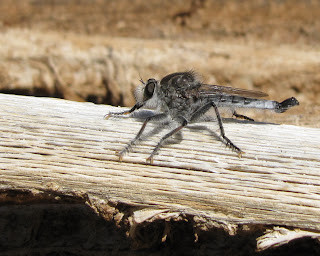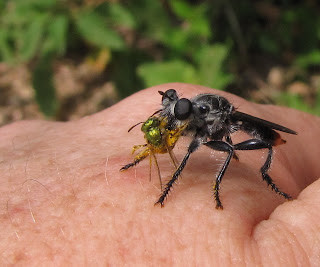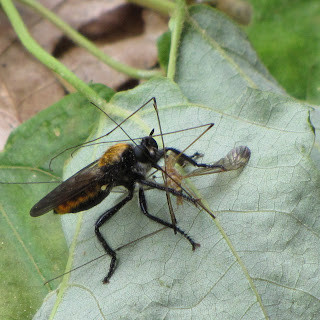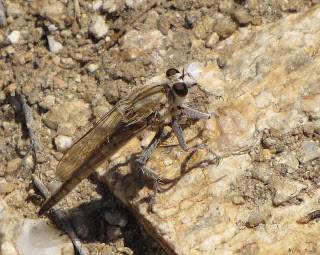Robber flies, often called “assassin flies,” are a common sight across various habitats, from the arid deserts of the southwest to almost everywhere else. You might have encountered these fascinating insects without realizing what they are, as they often bear a striking resemblance to wasps or bees, rather than typical house flies. Despite their intimidating appearance and predatory nature, a common question arises: Can Robber Flies Bite?

Efferia robber fly perched, showcasing its bee-like mimicry and robust body.
Robber Fly Diversity and Identification
The Asilidae family, to which robber flies belong, is incredibly diverse, with nearly a thousand species identified in North America alone, and the possibility of more yet to be discovered. Even experts are still uncovering new species, highlighting how much there is still to learn about these insects. For instance, a new species of Laphria was recently identified in Cincinnati, Ohio, based on specimens, demonstrating ongoing discoveries within this insect group.

Laphria robber fly species, displaying the wide variation in size and coloration within the Asilidae family.
Robber flies exhibit significant variation in size, ranging from a petite 3mm to a substantial 50mm. Their shapes and color patterns are equally diverse. Some species are masters of mimicry, closely resembling bumble bees, while others, such as those in the Leptogastrinae subfamily, are slender and camouflaged, allowing them to move almost invisibly through tall grasses.

Slender Tipuligaster robber fly, illustrating the diversity in body shape within robber fly subfamilies.
Despite their variations, there are common features that can help identify robber flies. A key characteristic is the distinct concave area between their eyes on the top of their head. This feature differentiates them from similar-looking flies like mydas flies and dance flies. Additionally, robber flies often have a “bearded” face, characterized by long hairs covering their mouthparts. Even with these hairs, their strong, beak-like mouthparts are usually visible.

Facial view of a robber fly, clearly showing the ‘bearded’ face and stout, piercing mouthparts.
Predatory Behavior and Hunting Tactics
Robber flies are masters of ambush predation and can be found in diverse habitats, from deserts to grasslands and forest edges with filtered sunlight. They favor perching spots on the ground, rocks, logs, tree trunks, or foliage, providing them with excellent vantage points to survey their surroundings and the sky above.
Observing a robber fly perched on a twig or leaf reveals their hunting strategy. They often cock their heads, keenly watching for flying insects passing by. They are incredibly agile and can abruptly launch from their perch to intercept prey mid-air, much like a flycatcher bird. While some species might have preferences, most robber flies are generalist predators, consuming a wide range of insects. Larger robber flies are capable of taking down substantial prey, including grasshoppers and even dragonflies.

Robber fly feeding on captured prey, illustrating their predatory prowess and feeding behavior.
A fascinating group within robber flies is the genus Diogmites, known as “hanging thieves.” These flies exhibit a unique behavior of dangling from their front or middle legs while manipulating their captured prey with their remaining legs, as seen with the Diogmites fly pictured with its skipperling prey.

Small robber fly with prey, highlighting the diverse sizes of insects they can capture.
Can Robber Flies Bite Humans?
While robber flies are equipped with piercing mouthparts used to subdue their insect prey, they are not known to bite humans defensively and do not carry diseases. Their “bite” mechanism is designed for injecting paralytic compounds and digestive enzymes into other insects. They target vulnerable areas on their prey, such as joints in the exoskeleton or the “necks” of insects. For beetles, they often strike when the elytra (wing covers) are open, exposing softer body parts. Once bitten, the prey quickly becomes paralyzed, and the robber fly proceeds to consume the liquefied internal tissues.
The Mysterious Larval Stage
While adult robber flies are commonly observed, their larval stage remains largely enigmatic. The larvae of the species that have been studied are known to be external parasites of beetle grubs or other insect larvae, indicating a predatory lifestyle from their early stages.
Further Exploration of Robber Flies
To better appreciate these remarkable insects, familiarizing yourself with the different genera of robber flies you might encounter is beneficial. Remember their resemblance to other insects besides flies can sometimes be misleading. Excellent resources for learning more include the image gallery at BugGuide.net. Herschel Raney’s robber fly website (http://www.hr-rna.com/RNA/Robber%20main%20page.htm), created by a nature photographer and asilid expert, is another outstanding resource. Additionally, a global robber fly website (http://www.geller-grimm.de/asilidae.htm) is maintained by a team of enthusiasts.

Laphria robber fly in natural habitat, showcasing their camouflage and typical perching behavior.
For those who prefer printed guides, the Kaufman Field Guide to Insects of North America features detailed plates and descriptions of robber flies.
Conclusion: Appreciating Robber Flies
Take the time to observe these “winged wonders” of the insect world. Stop, listen for the sudden cessation of a loud buzz (indicating a successful hunt), and look carefully. Despite their size, robber flies can be surprisingly cryptic. Observing them in their natural habitat is a rewarding experience, offering a glimpse into the fascinating world of insect predation.

Asilid robber fly species, encouraging observation and appreciation of these predatory insects.